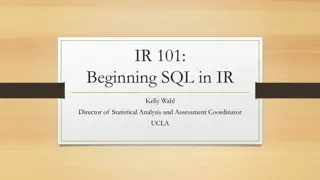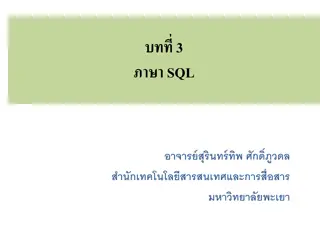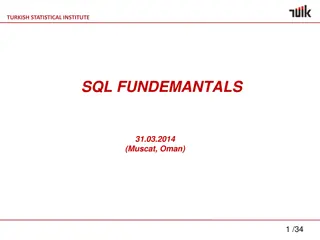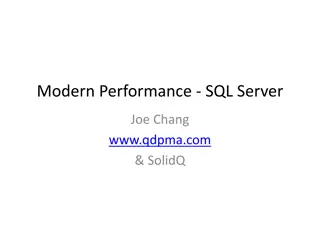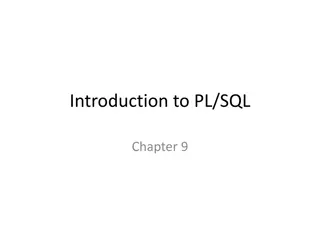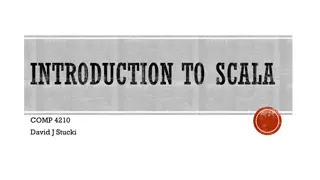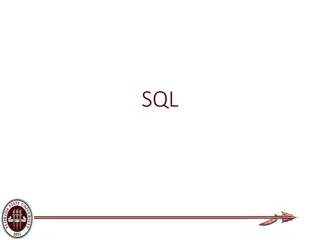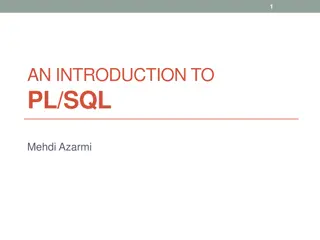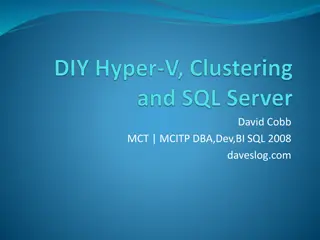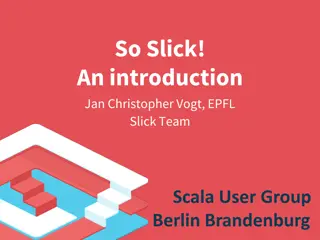
Slick SQL Interaction in Scala
Explore the benefits of using Slick in Scala for functional-relational mapping, predictable SQL structure, type-safety, schema consistency enforcement, and more. Discover how Slick simplifies database interactions through its Scala collection-like API and ensures compile-time safety, all while maintaining small configuration using Scala code.
Download Presentation

Please find below an Image/Link to download the presentation.
The content on the website is provided AS IS for your information and personal use only. It may not be sold, licensed, or shared on other websites without obtaining consent from the author. If you encounter any issues during the download, it is possible that the publisher has removed the file from their server.
You are allowed to download the files provided on this website for personal or commercial use, subject to the condition that they are used lawfully. All files are the property of their respective owners.
The content on the website is provided AS IS for your information and personal use only. It may not be sold, licensed, or shared on other websites without obtaining consent from the author.
E N D
Presentation Transcript
Slick SQL Interaction in Scala Jan Christopher Vogt, EPFL Slick Team
(vs. ORM) Functional-Relational Mapper natural fit (no impedance mismatch) declarative embraces relational stateless Slick is to ORM what Scalais to Java
1 Scala collection-like API
Scala collection-like API Device for ( d <- Devices; if d.price > 1000.0 ) yield d.acquisition id: Long price: Double acquisition: Date Devices .filter(_.price > 1000.0) .map(_.acquisition)
2 Predictable SQL structure
Predictable SQL structure Devices .filter(_.price > 1000.0) .map(_.acquisition) .selectStatement select x2."ACQUISITION" from "DEVICE" x2 where x2."PRICE" > 1000.0
3 Type-safety
Compile-Time Safety Spelling mistake in column name? Wrong column type? Query doesn t match the result type? scalac sees it all!
Caution: Error messages can be bad Error messages can destroy the illusion
Enforce schema consistency Generate DDL from table classes Slick 2.0: Generate table classes and mapped classes from database
4 Small configuration using Scala code
Table description class class Devices(tag: Tag) Devices(tag: Tag) extends extends Table[ def def id = column[Long] ( id = column[Long] ("ID" def def price = column[Double]( price = column[Double]("PRICE" def def acquisition = column[Date] ( acquisition = column[Date] ("ACQUISITION" def def * = (id, price, acquisition) * = (id, price, acquisition) Table[(Long, Double, Date) (Long, Double, Date)]( ](tag, tag,"DEVICE "DEVICE" ") { "ID", , O O. .PrimaryKey PrimaryKey) ) "PRICE") ) "ACQUISITION") ) ) { } def def Devices = Devices = TableQuery TableQuery[Devices] [Devices] can be auto-generated in Slick 2.0
Connect import scala.slick.driver.H2Driver.simple._ val db = Database.forURL( "jdbc:h2:mem:testdb", "org.h2.Driver") db.withTransaction { implicit session => // <- run queries here }
5 Explicit control over execution and transfer
Execution control Device val query = for { d <- Devices if d.price > 1000.0 } yieldd.acquisition id: Long price: Double acquisition: Date db.withTransaction { implicit session => (session) val acquisitonDates = query.run no unexpected behavior, no loading strategy configuration, just write code }
6 Loosely-coupled, flexible mapping
Table description class class Devices(tag: Tag) Devices(tag: Tag) extends extends Table[ def def id = column[Long] ( id = column[Long] ("ID" def def price = column[Double]( price = column[Double]("PRICE" def def acquisition = column[Date] ( acquisition = column[Date] ("ACQUISITION" def def * = * = (id, price, acquisition) (id, price, acquisition) Table[(Long, Double, Date (Long, Double, Date) )]( ](tag, tag,"DEVICE "DEVICE" ") { "ID", , O O. .PrimaryKey PrimaryKey) ) "PRICE") ) "ACQUISITION") ) ) { } val val Devices Devices = = TableQuery TableQuery[Devices] [Devices]
case class mapping case case class price price: Double, : Double, acquisition acquisition: Date) class Device Device( (id id: : Long, Long, : Date) class class Devices(tag: Tag) Devices(tag: Tag) extends extends Table[ def def id = column[Long] ( id = column[Long] ("ID" def def price = column[Double]( price = column[Double]("PRICE" def def acquisition = column[Date] ( acquisition = column[Date] ("ACQUISITION" = (id, price, acquisition) <> ( (Device.tupled,Device.unapply Device.tupled,Device.unapply) ) } val val Devices Devices = = TableQuery TableQuery[Devices] [Devices] Table[Device Device]( ](tag, tag,"DEVICE "DEVICE" ") { ) { , O O. .PrimaryKey PrimaryKey) ) "PRICE") ) "ACQUISITION") ) <> "ID", def def * * = (id, price, acquisition)
Custom mapping def def construct construct : (( def def extract extract: : ((Long,Double,Date Long,Double,Date)) => : CustomType CustomType => Option[( => Option[(Long,Double,Date )) => CustomType CustomType Long,Double,Date)] )] class class Devices(tag: Tag) Devices(tag: Tag) extends extends Table[ def def id = column[Long] ( id = column[Long] ("ID" def def price = column[Double]( price = column[Double]("PRICE" def def acquisition = column[Date] ( acquisition = column[Date] ("ACQUISITION" * = (id, price, acquisition) <> ( (construct,extract construct,extract) ) } val val Devices Devices = = TableQuery TableQuery[Devices] [Devices] Table[CustomType CustomType]( ](tag, tag,"DEVICE "DEVICE" ") { "ID", "PRICE") ) "ACQUISITION") ) <> ) { PrimaryKey) ) , O O. .PrimaryKey def def * = (id, price, acquisition)
7 Plain SQL support
Plain SQL support import scala.slick.jdbc.{GetResult, StaticQuery} import StaticQuery.interpolation implicit val getDeviceResult = GetResult(r => Device(r.<<, r.<<, r.<<)) val price = 1000.0 val expensiveDevices: List[Device] = sql"select * from DEVICE where PRICE > $price" .as[Device].list
8 composable / re-usable queries
Composable, re-usable queries def deviceLocations (companies: Query[Companies,Company]) : Query[Column[String],String] = { companies.computers.devices.sites.map(_.location) } re-use joins re-use queries val apples = Companies.filter(_.name iLike "%apple%") val locations : Seq[String] = { deviceLocations(apples) .filter(_.inAmerica: Column[String]=>Column[Boolean]) .run } re-use user-defined operators execute exactly one, precise query
Mental paradigm shift Non-composable executor APIs (DAOs) DevicesDAO .inPriceRange( 500.0, 2000.0 ) : List[Device] executes Composable query libraries devices .inPriceRange( 500.0, 2000.0 ) : Query[_,Device] composes
Suggested Slick app architecture View Controller Database Session Table classes Composable Query Library Non-composable Executor API / DAO Companies Computers Devices Sites def byId( Column[Long] ) : Query[ ,Computers] def byId( id:Long ) : Device def withComputers : Query[ ,( ,Computers)] def withComputers : Map[ ,Seq[Computer]] def iLike( Column[String] ) : Column[Boolean]
Relationships / Associations Via composable queries using foreign keys! companies.withComputers : Query[ ,(Company,Computer)] Not object references within query results Not executor APIs
Auto joins (only in play-slick sample app) implicitdef autojoin1 = joinCondition[Sites,Devices] implicitdef autojoin2 = joinCondition[Devices,Computers] (_.computerId === _.id) (_.id === _.siteId) sites.autoJoin(devices).further(computers) : Query[_,(Site,Computer)] sites.autoJoin(devices).autoJoinVia(computers)(_._2) : Query[_,((Site,Device),Computer)] Device Computer Site id: Long price: Double acquisition: Date siteId: Long Id: Long Name: String companyId: Int id: Long name: String 1 n n 1
Other features inserts += ++=, updates query.update( ) user defined column types, e.g. type-safe ids user defined database functions
2.0 is around the corner code-generation based type providers hlists and custom shapes (no 22-col limit, easy integration with shapeless, etc.) distributed queries (over multiple dbs) improved pre-compiled queries
Current experiments improved macro-based api (simpler types) macro-based type providers schema manipulation api migration/version management tool extended for-comprehensions (order, group) Thanks to @amirsh @clhodapp @nafg
Thank you slick.typesafe.com @cvogt @StefanZeiger http://slick.typesafe.com/talks/ https://github.com/cvogt/play-slick/

